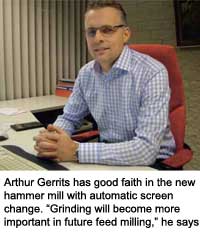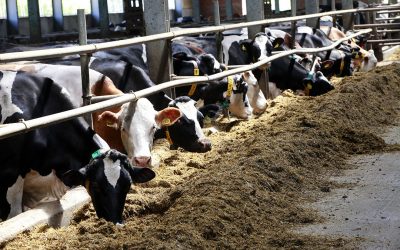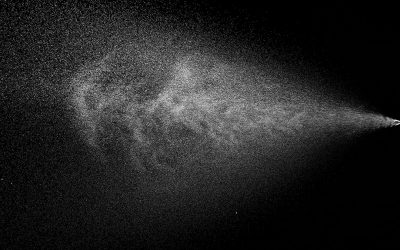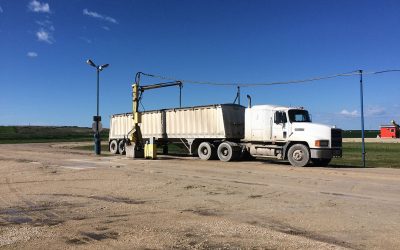Improved grinding with automatic screen change

Apart from the hammers and screens, hammer mills hardly wear and last for many years. In modern feed production with many recipes and changeovers, however, capacity, power consumption and flexibility, can be reasons to invest in more modern and adaptable machines. Arthur Gerrits of Fransen-Gerrits Feed in Erp, the Netherlands decided to trade in his old hammer mills for the new Van Aarsen hammer mills with automatic screen exchange.
By Dick Ziggers
It is clear that an optimal feed structure contributes to digestibility of the ingredients by the animal. Fine ground raw materials are easier to pellet, but often have a negative impact on digestibility. The type of animal or its life production stage requires specific coarseness of ingredients for optimum digestion. It is to the nutritionists to decide, but equipment suppliers should enable production of feeds with the desired particle spectrum.
With these requirements in mind equipment manufacturer Van Aarsen a few years ago started developing a new hammer mill. “The basic idea was to develop a mill with a wide range of applications,” says Piet van Bommel, area manager at Van Aarsen. “We were looking for a machine that has minimal energy consumption, an easy to adjust particle size output, an ergonomic design, compact dimensions and minimal wear parts.”
It took the engineers of Van Aarsen two years to develop a new concept of hammer mills which was unique in the market and followed the complete list of demands for modern grinding. In order to increase capacity the diameter of the grinding chamber was enlarged to 1,250 mm. By doing so the rotation speed could be decreased from 3,000 rpm to 1,500 rpm to keep the same maximum hammer tip speed of 90 m/s. “In practice we see that hardly any grinding takes place below the level of the axle, so in the new mill the top half of the grinding chamber consists of breaker plates and the bottom half is filled with screens. This way we make optimal use of gravity for discharging of ground feed,” says Van Bommel (see Figure 1).
Furthermore the hammer mill is equipped with an automatic magnet in the feeder to take out any metal part that could end up in the feed mix. Also temperature of the bearings and grinding chamber is monitored and there is a stand-still detection to secure safe opening of the doors. Next to these features the mill can run in two directions for optimal use of hammers and screens. Ergonomics have also been taken into account. For changing the hammers Van Aarsen designed a special tray that keeps the rotor with the hammers in position (instead of rotating back) when a row of hammers is removed.
Automatic screen change
Screens can be changed manually or automatically. The latter is of course the most remarkable feature of this new mill. A few equipment manufacturers have already experimented with this feature, but most of them changed screens at the front end of the mill. “This requires quite some space in the grinding area, so we stayed with the principle of changing the screens from the side, as is done in our previous types of hammer mills,” Van Bommel explains. “We designed a cassette containing three screens.” The hammer mill now has two (or four, depending on whether dealing with a 700 or 1,400 mm body length) cassettes, one on each side, that contain three screens each (Figure 2).The screens are pneumatically clamped to the grinding chamber. The screen is suspended in a cassette slot by means of a lever with pneumatic cylinder. During insertion the lever pushes the screen down into the mechanism. The insertion mechanism consists of motor driven wheels that place the screen into the hammer mill. Once in place, a clamp locks the screen into place and seals the hammer mill.
The advantage of this system is that minimum space is required. Screen change is simple, quick and secure and without leakage or dust emission between changing. The hammer mill does not require coming to a stop when the screens are replaced, which avoids peak loads in power use.
First placement
The new hammer mill was first placed at the feed plant of Fransen-Gerrits in Erp, the Netherlands. The company manufactures about 500,000 tonnes of feed for pigs, poultry and cattle in four specialised mills. Fransen-Gerrits makes quite some concentrates for pig farmers that use wet feeding systems. These recipes change frequently over time, depending on the (wet) raw materials the farmers purchase. To service these farms a company needs to be flexible.The mill in Erp needed refurbishment. “We decided to redo our production unit in Erp from top to bottom,” says Arthur Gerrits, director for production and logistics. “One of the items was to replace our existing hammer mills with more flexible ones, since we do quite some tailor-made production. We already used Van Aarsen equipment and when I studied the features of the new GD hammer mill I was convinced that this was the one that could help achieve our goals.”
“They’re robust and with the speed adjustment through a frequency controller it could add to our flexibility,” Gerrits continues. “At first I ordered the mill with manual screen changing. The first one was placed in January 2009. Actually, I bought the automatic screen change feature from a computer image, which eventually was added to the mills in September 2009!”
At Fransen-Gerrits screen size for milling is incorporated in the recipe. Raw materials are mixed and then ground. Between batches the frequency controller steers the rotor to the right speed and the required screen is placed. Varied rotor speed from 450 to 1,500 rpm and three screen sizes give optimum flexibility in particle size (Figure 3). “Because of this flexibility in speed and screen size the spectrum in particle size is very broad. In my experience it eliminates the need for a roller mill,” Gerrits adds. “Grinding of feeds has been neglected lately. I believe that feed structure and particle size is the future for compounders.”
Recently the feed plant of Fransen-Gerrits in De Rips has also been equipped with two of the new Van Aarsen GD Hammer mills with automatic screen change.











